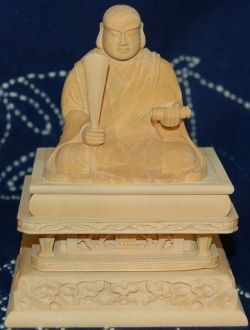Opening of the Eyes
Opening of the Eyes [開目抄] (Jpn Kaimoku-sho )
One of Nichiren's five or ten major writings. It consists of two volumes and was completed at Tsukahara on Sado, an island in the Sea of Japan, in the second month of 1272. According to Nichikan (1665-1726), the twenty-sixth chief priest of Taiseki-ji temple, in this work Nichiren reveals his identity as The Buddha of the Latter Day of the Law who possesses the three virtues of sovereign, teacher, and parent. Thus he says it reveals the object of devotion in terms of the Person, while The Object of Devotion for Observing the Mind, written in 1273, reveals the object of devotion in terms of the Law.
The Opening of the Eyes begins with the words: "There are three categories of people that all human beings should respect. They are the sovereign, the teacher, and the parent" (220). In the concluding part, Nichiren says, "I, Nichiren, am sovereign, teacher, and father and mother to all the people of Japan" (287). Because in this statement Nichiren identifies himself with the three virtues the Buddhas possess, it is viewed as his declaration that he is The Buddha of the Latter Day of the Law. He also states: "On the twelfth day of the ninth month of last year [1271], between the hours of the rat and the ox [11:00 .. to 3:00 ..], this person named Nichiren was beheaded. It is his soul that has come to this island of Sado and, in the second month of the following year, snowbound, is Writing this to send to his close disciples" (269).
"This person named Nichiren" means the ordinary person Nichiren. "It is his soul that has come to this island of Sado" is taken to mean that the individual who arrived alive at Sado was Nichiren in his true identity— The Buddha Nichiren.The title The Opening of the Eyes means to open the Eyes of the people and awaken them to the three virtues of the Buddhism of the harvest and finally to those of the Buddhism of sowing, severing their blind Attachment to the provisional teachings. In doing so, Nichiren discusses the relative superiority of the lifetime teachings of Shakyamuni (with the Doctrine known as the fivefold comparison), determines the superiority of the Lotus Sutra over all other Sutras, and reveals the Mystic Law, the teaching for attaining Buddhahood in the Latter Day of the Law.
He says: "The Doctrine of three thousand realms in a single moment of Life [i.e., the Mystic Law] is found in only one place, hidden in the depths of the 'Life Span' chapter of the essential teaching of the Lotus Sutra. Nagarjuna and Vasubandhu were aware of it but did not bring it forth into the Light. T'ient'ai Chihche alone embraced it and kept it ever in Mind" (224). Based on this passage, Nichikan later established the Doctrine of the threefold secret teaching. In his work known as The Actions of the Votary of the Lotus Sutra, Nichiren writes: "I began to put into shape a work in two volumes called The Opening of the Eyes, which I had been working on since the eleventh month of the previous year. I wanted to record the wonder of Nichiren, in case I should be beheaded" (772).
The Opening of the Eyes, which was intended for posterity, was given to ShijoKingo, a lay Disciple who had accompanied Nichiren to the execution site at Tatsunokuchi and resolved to die there by his side. See also fivefold comparison; threefold secret teaching.
